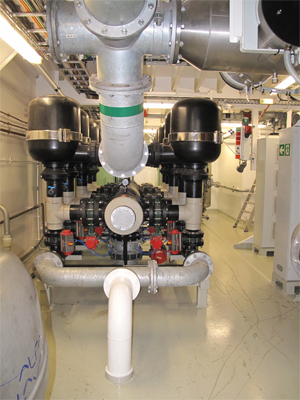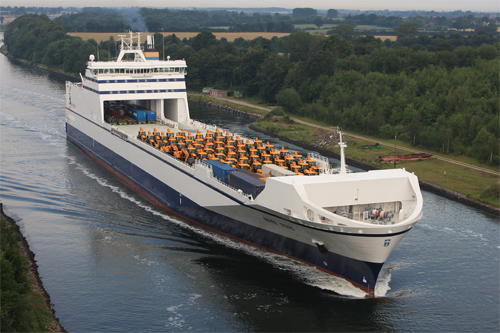As vessel operators brace themselves for impending ballast water regulations, new technologies offer an opportunity to prevent the spread of invasive species in marine ecosystems. The majority of market-ready ballast water management systems combine first stage filtration with either UV radiation or chemical disinfection. But the emergence of new technologies is expanding the choices available to vessel owners.
The member nations of the International Maritime Organization (IMO) are nearing ratification of the International Convention for the Control and Management of Ships' Ballast Water and Sediments.
As of Nov. 30, 2011, 31 member nations representing 26.44 percent of the world merchant shipping tonnage have ratified the convention, just short of the requirement of 30 nations representing at least 35 percent of the world gross tonnage. The convention would enter into force 12 months after its ratification.
The convention would establish standards that prohibit the release of ballast water containing more than 10 larger organisms per cubic meter of ballast water or certain concentrations of smaller organisms. It would further institute a timeframe mandating the compliance of all vessels by 2016.
Concurrently, the U.S. Coast Guard has proposed a two-phase plan involving a standard 1,000 times more stringent than international law. The Environmental Protection Agency's Science Advisory Board has found that no current ballast water management system can meet that goal. Additionally, 26 states, two Indian tribes, and a U.S. territory have passed local laws. Many of these laws will necessitate compliance before the IMO timeframe and at greater levels of stringency. Vessel operators must be prepared to meet the strictest standard of any port in which they deballast.
To meet these standards, shipowners will need to invest in the most effective system available while taking into account additional concerns. These concerns include the operating and life cycle costs of the system, space requirements, the cost of retro-fitting, maintenance concerns, and the need for additional crew training. If the system uses active chemicals, safety procedures must also be employed to ensure neutralization.
As of November 2011, a total of 19 ballast water management systems have received type approval from a flag state administration in accordance with IMO resolution MEPC.174(58). Six type approved systems that have had proven market success are discussed below.
Hyde Guardian
The frontrunner among American-made systems is the Hyde Guardian, which combines self-cleaning disk filtration that removes sediment and larger organisms with a UV disinfection unit that kills smaller organisms. Hyde Marine Inc. has been a pioneer in the development of ballast water management systems, first installing the Guardian on the cruise ship Coral Princess in 2003. Well over 100 systems have been sold, including six systems which were delivered for installation aboard the British Royal Navy's two Queen Elizabeth Class aircraft carriers in 2008.
 |
|
The Hyde Guardian HG 700 system on Bore Song employs filtration followed by UV disinfection. (Photo courtesy Hyde Marine Inc.) |
Tom Mackey, senior consultant for Hyde Marine, said the company's "philosophy has been to take the simplest and most direct technical approach in the design and selection of components and to deliver the most reliable ballast water management system possible."
The Guardian's treatment process occurs automatically with little or no crew supervision. The modular design can be configured in a variety of shapes, allowing for easy accommodation below deck.
For most vessels, installing the Guardian does necessitate the replacement of ballast pumps or an upgrade in electrical generating capacity. The system is designed for a minimal pressure drop, and its UV technology consumes a modest amount of energy.
Finally, the Guardian's treatment process does not employ active substances, eliminating a number of concerns regarding safety, chemical neutralization and increased corrosion in piping and ballast tanks.
OceanSaver
The Norwegian company OceanSaver offers a ballast water management system specially designed for large ships. The OceanSaver ballast water system combines a fully automatic back-flushing filter with a disinfectant produced in an electrodialytic process known as water activation. Following filtration, OceanSaver's primary treatment module uses 1.6 percent of the seawater taken up during ballasting to create an oxidant. The oxidant is then injected into the ballast water stream where it reacts with seawater to form hypobromite, a disinfectant similar to chlorine in swimming pools. An optional third step uses nitrogen supersaturation to prevent pipe corrosion.
OceanSaver's treatment method involves two complications. First, a neutralizer must be added to make the water safe for discharge if the residual oxidant level is over 0.2 ml/liter. Basic crew training is needed to administer this step. Second, an aft peak tank is needed in areas of low salinity to supply the requisite seawater for water activation.
The OceanSaver is a promising system for larger vessels, as it can handle up to 10,000 cubic meters of ballast water per hour without delaying operations. The system is designed to last the lifetime of the vessel, has a modest electrical footprint and entails a minimal pressure drop. The OceanSaver was recently installed on Höegh Trove, a Norwegian car carrier with a cargo capacity of 6,500 CEU (car equivalent units).
Optimarin
Optimarin of Norway offers a treatment system that combines filtration and UV radiation, the same principles used by the Hyde Guardian.
Birgir Nilsen, vice president of business development, described the Optimarin Ballast System (OBS) as "a very simple, self-cleaning filtration and UV system, that requires low maintenance — often as simple as changing a lamp."
The system does differ from the Hyde Guardian, however, in the design of its filter module and UV light system. The OBS uses either a basket-type or a candle-type filter, as opposed to the Hyde Guardian's stacked-disk filter system. Furthermore, Optimarin's UV light system is capable of effectively treating water at a higher level of turbidity, albeit at a higher energy cost.
The OBS entails a very low-pressure drop resulting in a minimal effect on ballast pump capacity. Corrosion is not a concern, as the filter module is rubber lined, the UV chamber is made of non-corrosive copper and nickel and the system produces no active chemicals. The system is usually installed in the pump room or the engine room and can be configured vertically or horizontally to efficiently use space.
In May 2011, Optimarin signed a contract with Grieg Shipping Group to deliver 10 systems for installation aboard 10 cargo carriers currently under construction at the Hyundai Mipo Dockyard in South Korea.
Electro-Cleen
The Electro-Cleen System, developed by Techcross Inc., of South Korea, consists of an electrolysis-generating chamber inserted directly into the main seawater pipe line located in the rear side of the ballast pump. The so-called Electro-Chamber also produces OH radicals which act as a secondary disinfectant. After treatment, residual disinfectant flows into the ballast tank, where it prevents the regrowth of organisms.
Despite Electro-Cleen's use of active substances, neutralization is only needed on short voyages, as residual oxidants in the ballast tank degrade to environmentally safe levels after a few days.
The Electro-Cleen System entails lower energy consumption than systems using UV technology and requires no additional crew training. The system does not necessitate the replacement of ballast pumps.
Importantly, the Electro-Cleen System met California's performance standards (which are 1,000 times more stringent than the IMO's) over 70 percent of the time during land-based testing. This suggests that the Electro-Cleen System has the potential to meet the U.S. Coast Guard's Phase Two standard and any future laws of greater stringency.
The Electro-Cleen System was recently installed on GL Xiushan, a 98,000-dwt Chinese bulker. The installation marks the first time a ballast water treatment system has been installed on a newly constructed post-Panamax bulker.
PureBallast 2.0
The PureBallast 2.0, manufactured by Swedish company Alfa Laval, treats ballast water through a process called advanced oxidation technology (AOT). After a 40 micron mesh filter blocks the uptake of sediment and larger organisms, one or more Wallenius AOT units generate radicals which break down the cell membranes of smaller organisms. The PureBallast 2.0 must be scaled to accommodate the flow rate of the vessel. Each individual AOT unit is capable of handling a flow of 250 cubic meters per hour, meaning that a vessel with a flow rate of 2,500 cubic meters per hour will use 10 AOT units. If the vessel's flow rate exceeds 2,500 cubic meters per hour, an entirely separate system must be installed. The PureBallast 2.0's modular design can be installed in a variety of configurations to match the vessel's layout.
The PureBallast 2.0 is designed for start-and-forget operation and places minimal responsibilities on the crew. The PureBallast 2.0 does not employ active substances, eliminating safety concerns and the risk of exacerbating corrosion.
Notable installations of the PureBallast 2.0 include two systems aboard the Royal Australian Navy's Landing Helicopter Dock vessels, and one system aboard the British arctic drillship Stena DrillMAX ICE, both in 2010.
BalPure
BalPure treats ballast water by combining first-stage filtration with second-stage electrolytic disinfection. The system is manufactured by Severn Trent De Nora, a marine technology company with 35 years of electrolytic disinfection experience.
After a 40-micron filter removes larger organics, a side stream constituting 1 percent of the uptake flow rate is delivered to an electrolytic unit. Here ocean water is electrolyzed to generate hypochlorite, a disinfectant used in swimming pools. The solution of depleted seawater, hypochlorite and hydrogen gas then passes through a cyclone to separate the hydrogen gas and vent it into the atmosphere.
The hypochlorite solution is injected on the discharge side of the ballast pump or pumps, disinfecting the ballast tank and providing enough residual disinfectant to prevent the regrowth of organisms during the ballast cycle.
During deballasting, sodium bisulfate is added to the suction side of the ballast pump to neutralize residual hypochlorite.
Like most treatment systems involving electrolysis, BalPure uses an aft peak tank containing ocean water in areas of low salinity. At least three ballasting cycles can be completed with the reserve tank.
BalPure is a fully automated system involving minimal crew training. It uses little space below deck and can be configured without moving existing mechanical equipment. The only operating cost is the electricity used to produce hypochlorite. The system has been confirmed by a third party as being non-corrosive and will not impact the lifespan of ballast tanks or pipes.
BalPure underwent shipboard testing on California Maritime Academy's training ship, T. S. Golden Bear, from May to December 2010, where it surpassed the IMO standard. The system subsequently received Type Approval from the IMO in July 2011.

